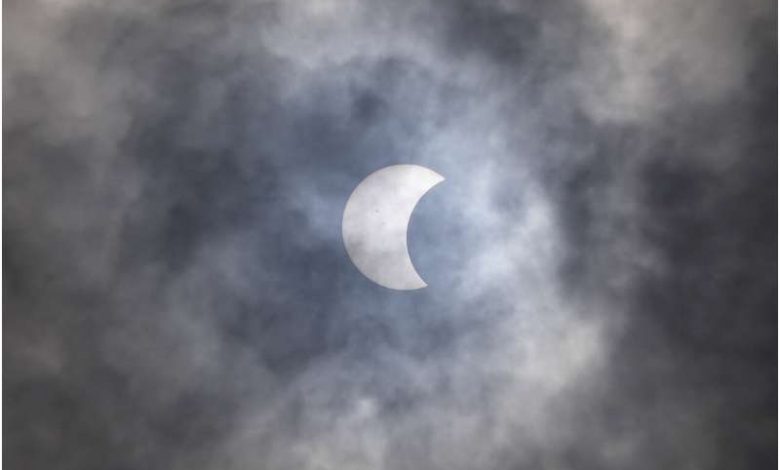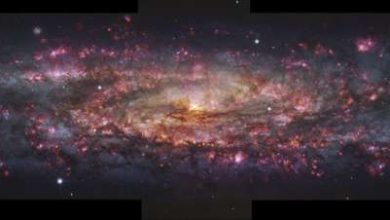‘Awesome’ solar eclipse wows viewers in Australia, Indonesia

Under a cloudless sky, 20,000 eclipse chasers crowded a tiny outpost to watch a rare solar eclipse plunge part of Australia’s northwest coast into brief midday darkness Thursday while temporarily cooling the tropical heat.
The remote tourist town of Exmouth, with fewer than 3,000 residents, was promoted as one of the best vantage points in Australia to see the eclipse that also crossed remote parts of Indonesia and East Timor.
An international crowd had been gathering for days, camping in tents and trailers on a red, dusty plain on the edge of town with cameras and other viewing equipment pointed skyward.
NASA astronomer Henry Throop was among those at Exmouth cheering loudly in the darkness.
“Isn’t it incredible? This is so fantastic. It was mind-blowing. It was so sharp and it was so bright. You could see the corona around the sun there,” the visibly excited Washington resident said.
“It’s only a minute long, but it really felt like a long time. There’s nothing else you can see which looks like that. It was just awesome. Spectacular. And then you could see Jupiter and Mercury and to be able to see those at the same time during the day—even seeing Mercury at all is pretty rare. So that was just awesome,” Throop added.
First-time eclipse chaser Julie Copson, who traveled more than 1,000 kilometers (600 miles) north from the Australian west-coast port city of Fremantle to Exmouth, said the phenomenon left her skin tingling.
“I feel so emotional, like I could cry. The color changed and seeing the corona and sun flares …,” Copson said.
“It was very strong and the temperature dropped so much,” she added, referring to a sudden 5-degree-Celsius (9-degree-Fahrenheit) fall in temperature from 29 degrees Celsius (84 Fahrenheit) when the moon’s shadow enveloped the region.
It was the fifth eclipse for Detroit resident Shane Varrti, who began planning his trip to Exmouth a year ago.
“It’s very exciting. All this effort has come to fruition,” Varrti said.
In Indonesia’s capital, hundreds came to the Jakarta Planetarium to see the partial eclipse that was obscured by clouds.
Azka Azzahra, 21, came with her sister and friends to get a closer look by using the telescopes with hundreds of other visitors.
“I am still happy to come even though it is cloudy. It is happy to see how people with high enthusiasm come here to see the eclipse, because it is rare,” Azzahra said.
The call to prayer resounded from the city’s mosques when the eclipse phase began as Muslims in the country with the world’s largest Muslim population said eclipse prayers as a reminder of God’s greatness.
In East Timor, people gathered around the beach in Lautem municipality, waiting to witness the rare solar eclipse through their eclipse glasses. Some of them came from other countries and gathered with locals to have a clear view of the eclipse.
“Timor Leste is one of the unique countries where the experience is less humid, less cloudy, so we are expecting a clear sky, that’s why many international astronomers wish to converge here. We are hoping that there is going to be a clear sky,” Zahri Bin Ahmad, astrophile from the South East Asia Astronomy Network of Brunei said as they waited Thursday.
People cheered as the sun and moon reached maximum eclipse.
“This is a very new natural phenomenon for Timor Leste. It is very important for us to be able to watch and experience it firsthand,” said Martinho Fatima, a civil protection authority officer.
The hybrid solar eclipse tracked from the Indian Ocean to the Pacific Ocean and was mostly over water. The lucky few people in its path either saw the darkness of a total eclipse or a “ring of fire” as the sun peeked from behind the new moon.
Such celestial events happen about once every decade: The last one was in 2013 and the next one isn’t until 2031. They occur when Earth is in the “sweet spot” so the moon and the sun are almost the exact same size in the sky, said NASA solar expert Michael Kirk.
At some points, the moon is a little closer and blocks out the sun in a total eclipse. But when the moon is a little farther away, it lets some of the sun’s light peek out in an annular eclipse.





